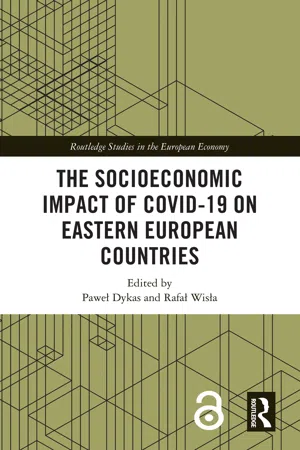
The Socioeconomic Impact of COVID-19 on Eastern European Countries
Rafał Wisła, Paweł Dykas
- 154 pages
- English
- ePUB (mobile friendly)
- Available on iOS & Android
The Socioeconomic Impact of COVID-19 on Eastern European Countries
Rafał Wisła, Paweł Dykas
About This Book
The year 2020 went down in economic history due to the dramatic and drastic changes in economic and social conditions that resulted from the outbreak of the global pandemic of COVID-19. This book offers a multi-level narrative about the pandemic, written from national and international perspectives, enabling the authors to construct several macro- and mega-scenarios.
The book consists of six chapters. Four of them discuss the process of the COVID-19 pandemic caused by the SARS-CoV-2 virus in Europe in 2020, i.e. the directions and dynamics of the spread and its socioeconomic consequences, and provide a comparative analysis of fiscal and monetary packages employed by Europe, with an emphasis on Eastern European countries. The remaining two chapters contain forecasts and scenarios. The fifth chapter, dedicated to forecasts, provides readers with a comprehensive description of possible consequences of any epidemic leading to severe social losses such as high percentages of infected and dead, limited interpersonal contacts as a result of lockdown, a lowered level of general individual and social well-being, as well as economic losses, for example a decline in production as a result of the collapse of aggregate demand and a reduction in the supply capacity of the economy, consequently slowing down the pace of capital accumulation. The sixth, final chapter describes possible scenarios of the spread of the pandemic in Poland and Ukraine, depending on measures taken by the governments of those countries.
The Socioeconomic Impact of COVID-19 on Eastern European Countries is designed as a practical reference for scholars, researchers and policymakers.
The Open Access version of this book, available at www.taylorfrancis.com, has been made available under a Creative Commons Attribution-Non Commercial-No Derivatives 4.0 license.